Dell Studio XPS 16: the Eyes Have It
by Jarred Walton on April 2, 2009 6:00 PM EST- Posted in
- Laptops
Gaming Performance
We've chosen to focus on "reasonable" settings for the games below. That means we run Assassin's Creed and Company of Heroes in DX9 mode at maximum detail setting - DX10 reduces performance by quite a bit in AC and by a much larger amount in CoH. We run Crysis at Medium settings (for reference, High detail drops performance almost in half: 8.8 FPS for the XPS 16 at 1680x1050). The remaining games are at maximum detail settings, but without any anti-aliasing.
Again, we chose to focus on 1680x1050 as a baseline performance comparison, and we will do so with other laptops going forward. If necessary, we will use an external LCD to run at that resolution. Besides 1680x1050, we will also include results at the native LCD resolution, and for less powerful laptops like the Studio XPS 16 we will add 1280x800 performance. (Note that performance at 1366x768 - a 16:9 aspect ratio - is virtually identical to results at 1280x800.) Ideally, you would want to run any laptop at the native LCD resolution, but depending on the game and your hardware that may not be practical.
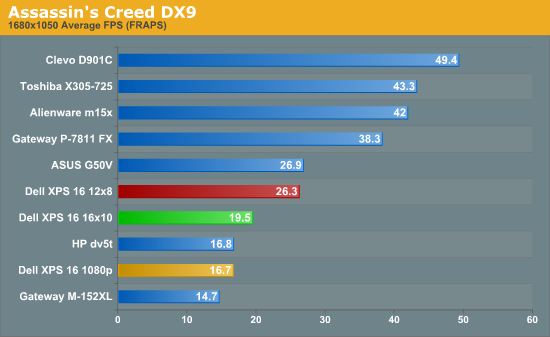
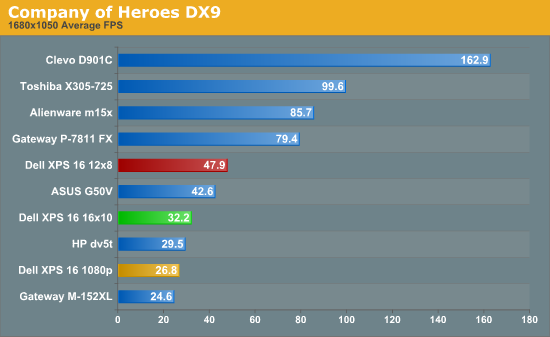
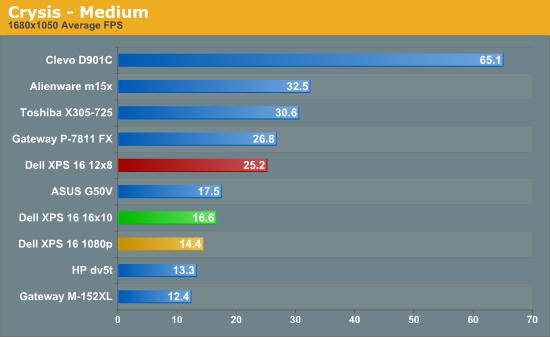
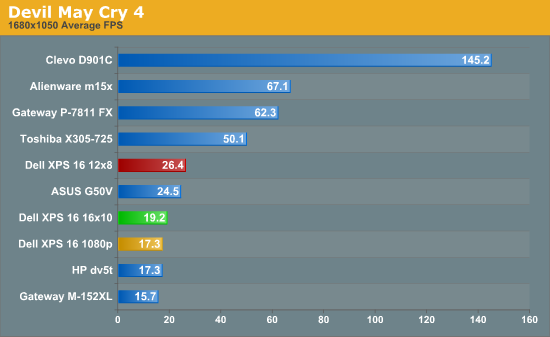
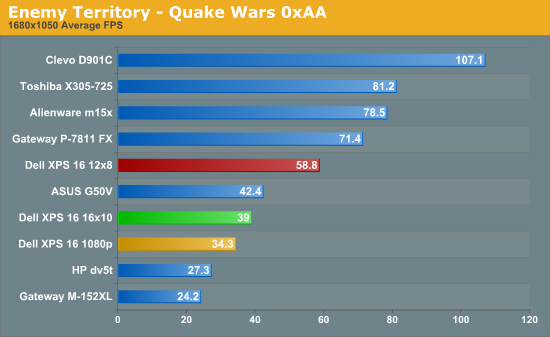
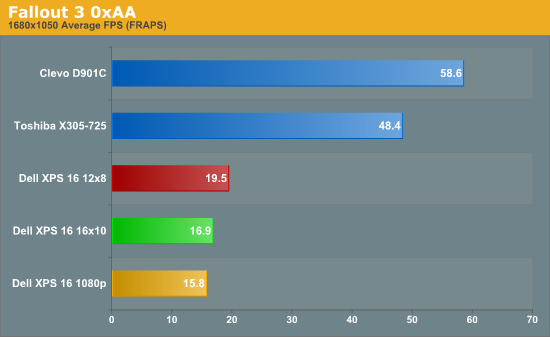
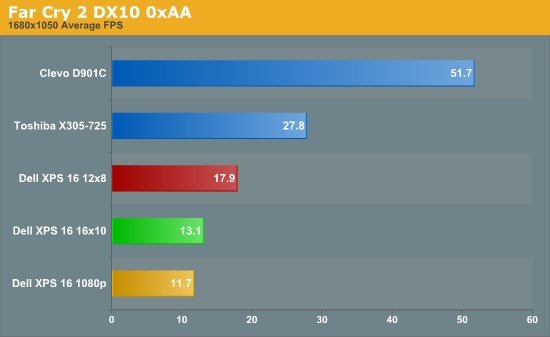
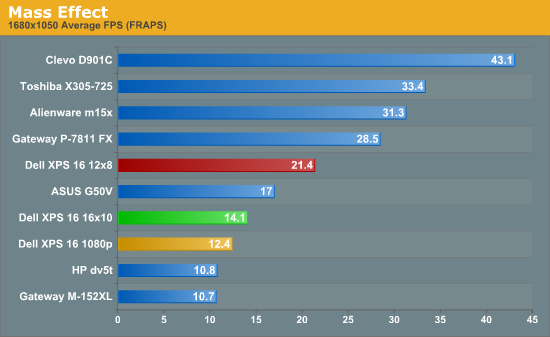

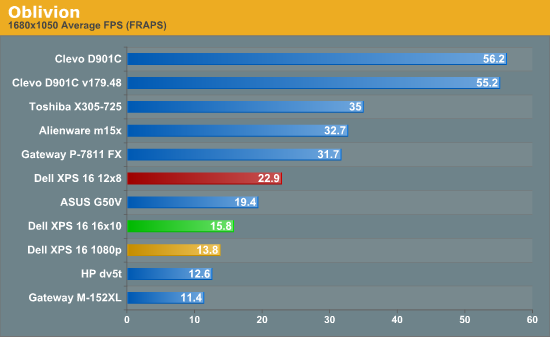
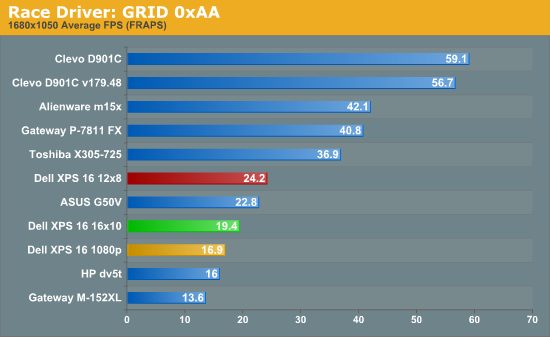
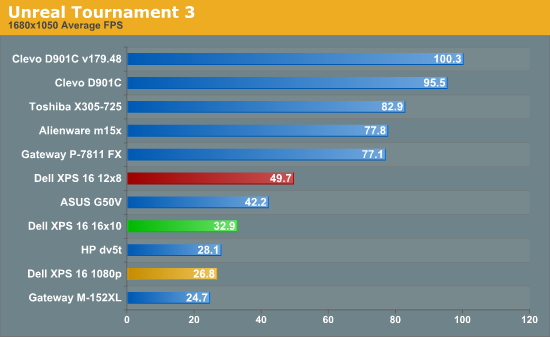
The gaming results are what you would expect from a Radeon HD 3670. If you look at the green bar, which represents equivalent performance at 1680x1050, the Studio XPS 16 is slower than the GeForce 9700M GT in the ASUS G50V but stays well ahead of the GeForce 9600M GT in the HP dv5t. Another way of looking at it is that performance at 1280x800 is almost equal to what you can get from the 9700M GT at 1680x1050; conversely, 1080p performance essentially matches the 9600M GT at 1680x1050.
As we mentioned earlier, we performed the initial benchmarks using outdated drivers. Updating to the latest drivers from Dell's website improved performance by 3-5% in several titles that we checked (Far Cry 2, Crysis, and Unreal Tournament 3). That's not a big enough change to affect the standings or our recommendation, but if you get an XPS 16 you'll want to verify that you're running the latest drivers.
Put simply, if you are interested in purchasing a laptop that can provide reasonable gaming performance, you really need at least a GeForce 9700M and preferably a 9800M - or a Mobility Radeon HD 4650 and preferably a 4830 from the ATI side. It's not that you can't game on lower end graphics solutions, but there are plenty of titles where you will need to drastically reduce resolution or detail settings in order to provide acceptable frame rates. As far as ATI versus NVIDIA goes, the latest ATI products do a great job at closing the performance gap that has existed for a while now in the mobile sector - we will have a look at a notebook in the near future that might even take the performance crown from NVIDIA.
The driver situation muddies the waters greatly, however, and we would really have a difficult time recommending against NVIDIA for a high-end gaming laptop unless and until ATI begins to offer "mobile reference drivers". Yes, it's possible to hack desktop drivers and make them work, but that definitely isn't the preferred solution. It's also a little disconcerting that when you go to ATI's website and look for Mobility Radeon drivers, many options aren't even listed - for example, the 3600 series used in the Studio XPS 16 is entirely absent. NVIDIA also has CUDA and PhysX to further tilt the scales in their favor, if you buy into the marketing. Overall, the Mobility HD 3670 is decent, but there are now better options. Unfortunately, adoption of new mobile GPUs often lags behind their official release by several months, which is why this new Studio XPS 16 uses a GPU that launched early last year.










79 Comments
View All Comments
JarredWalton - Friday, April 3, 2009 - link
All 3DMark scores are at the standard 3DMark resolution, so I connect an external LCD where necessary (i.e. laptops with 1280x800 LCDs can't run 1280x1024 in 3DMark06 and Vantage). So the scores are definitely apples-to-apples in that department.I don't know what WoW is really like in terms of GPU needs, but the HD 3670 should be faster than the 8600M GT by a fair margin. If you need more power, though, Gateway's P-7808u FX should do the trick (review in progress), and MSI's GT627 is even more powerful in the GPU department (9800M GT). The only caveat is that neither LCD is anywhere near as good as the Studio XPS 16, and I really dislike the MSI keyboard (it's flimsy).
jiggpig - Thursday, April 2, 2009 - link
You should add the lenovo x200 or x300 to the battery life charts, I bet they could challenge the macbooks in battery life/battery size charts.JarredWalton - Thursday, April 2, 2009 - link
I would if Lenovo would send me a laptop to test. I've heard good things from some people, and I would love to verify the results. Without doing the testing myself, however, I can't come to any firm conclusion. (What brightness level do they test at? What's the test like? That sort of stuff can make a difference.)erple2 - Tuesday, April 7, 2009 - link
Also, I see that you've posted the minutes/WHr results for the Apple notebooks. However, what are the "at the wall" measurements for power consumption?Is it that OSX is that much stronger optimized for low power usage? I wonder if there would be any difference running Linux vs. Vista vs. OSX on the same laptop (granted, you'd have to run them all on a Macbook I suppose to get that result) at least for power consumption, and wall outlet consumption.
Hrel - Thursday, April 2, 2009 - link
Which GPU does it have in it? Sometimes you list the HD4670 and sometimes you say HD4650???Hrel - Thursday, April 2, 2009 - link
I meant HD3670 and HD3650... ah typing mistakes that are made significant by barely different product naming schemes.JarredWalton - Thursday, April 2, 2009 - link
Sorry about that... it's an HD 3670, but somehow in the process of writing I started saying 3650. The two chips are the same, other than clock speeds, but I'm not sure on the clocks for the 3650. Anyway, the incorrect part numbers have been corrected. Thanks!Hrel - Thursday, April 2, 2009 - link
"This will allow us to provide an apples-to-apples comparison with other laptops while also showing the performance range you can expect by lowering or increasing the resolution."YAY anandtech! Good job, now if only you would do this on every single review that has anything to with GPU's. Oh, I'm not done with the article yet, but if there aren't 3D Mark scores, there should be.
LoneWolf15 - Friday, April 3, 2009 - link
Yes, because 3DMark scores are SO indicative of real-world performance.[/sarcasm]
cheetah2k - Saturday, April 4, 2009 - link
It would be nice to see 3Dmark06 scores across the whole Dell range in these reviews, including the hefty XPS1730.For those wanting to know, an XPS1730 with 2 x 8800GTX in Sli gets 11,490 marks in 1280x1024 with a T9300 CPU @ 2.5Ghz